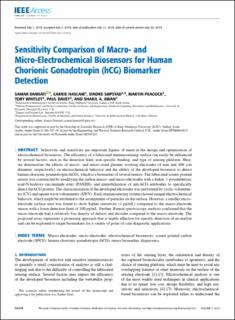| dc.contributor.author | Damiati, Samar | |
| dc.contributor.author | Haslam, Carrie | |
| dc.contributor.author | Søpstad, Sindre | |
| dc.contributor.author | Peacock, Martin | |
| dc.contributor.author | Whitley, Toby | |
| dc.contributor.author | Davey, Paul | |
| dc.contributor.author | Awan, Shakil A. | |
| dc.date.accessioned | 2020-04-07T09:37:04Z | |
| dc.date.available | 2020-04-07T09:37:04Z | |
| dc.date.created | 2019-11-27T17:32:47Z | |
| dc.date.issued | 2019 | |
| dc.identifier.citation | Damiati, S., Haslam, C., Søpstad, S., Peacock, M., Whitley, T., Davey, P., & Awan, S. A. (2019). Sensitivity Comparison of Macro- and Micro-Electrochemical Biosensors for Human Chorionic Gonadotropin (hCG) Biomarker Detection. IEEE Access, 7, 94048-94058. | en_US |
| dc.identifier.issn | 2169-3536 | |
| dc.identifier.uri | https://hdl.handle.net/11250/2650623 | |
| dc.description.abstract | Selectivity and sensitivity are important figures of merit in the design and optimization of electrochemical biosensors. The efficiency of a fabricated immunosensing surface can easily be influenced by several factors, such as the detection limit, non-specific binding, and type of sensing platform. Here, we demonstrate the effects of macro- and micro-sized planner working electrodes (4 mm and 400 μm diameter, respectively) on electrochemical behavior and the ability of the developed biosensor to detect human chorionic gonadotropin (hCG), which is a biomarker of several tumors. The fabricated screen-printed sensor was constructed by modifying the carbon macroand micro-electrodes with a linker, 1-pyrenebutyric acid-N-hydroxy-succinimide ester (PANHS), and immobilization of anti-hCG antibodies to specifically detect the hCG protein. The characterization of the developed electrodes was performed by cyclic voltammetry (CV) and square wave voltammetry (SWV). Each immunosensing system showed unique electrochemical behavior, which might be attributed to the arrangement of particles on the surface. However, a smaller microelectrode surface area was found to show higher sensitivity (1 pg/mL) compared to the macro-electrode sensor with a lower detection limit of 100 pg/mL. Further, Raman spectroscopy analysis confirmed that the micro-electrode had a relatively low density of defects and disorder compared to the macro-electrode. The proposed assay represents a promising approach that is highly effective for specific detection of an analyte and can be exploited to target biomarkers for a variety of point-of-care diagnostic applications. | en_US |
| dc.language.iso | eng | en_US |
| dc.rights | Navngivelse 4.0 Internasjonal | * |
| dc.rights.uri | http://creativecommons.org/licenses/by/4.0/deed.no | * |
| dc.title | Sensitivity Comparison of Macro-and Micro-Electrochemical Biosensors for Human Chorionic Gonadotropin (hCG) Biomarker Detection | en_US |
| dc.type | Peer reviewed | en_US |
| dc.type | Journal article | en_US |
| dc.description.version | publishedVersion | en_US |
| dc.source.pagenumber | 94048-94058 | en_US |
| dc.source.volume | 7 | en_US |
| dc.source.journal | IEEE Access | en_US |
| dc.identifier.doi | 10.1109/ACCESS.2019.2928132 | |
| dc.identifier.cristin | 1753367 | |
| cristin.ispublished | true | |
| cristin.fulltext | original | |
| cristin.qualitycode | 1 | |

